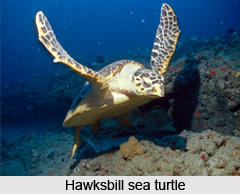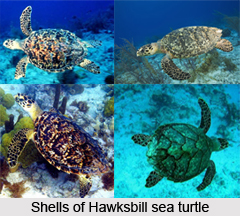 Hawksbill Sea Turtle is an Indian Marine Species that bears a scientific name "Eretmochelys imbricate" is a critically endangered sea turtle belonging to the family of Cheloniidae.
Hawksbill Sea Turtle is an Indian Marine Species that bears a scientific name "Eretmochelys imbricate" is a critically endangered sea turtle belonging to the family of Cheloniidae.
Category of Hawksbill Sea Turtle
Hawksbill`s appearance is similar to that of other marine turtles. In general it has a flattened body shape, a protective carapace, and flipper-like arms, adapted for swimming in the open ocean. E. Imbricata is easily distinguished from other sea turtles by its sharp, curving beak with prominent tomium, and the saw-like appearance of its shell margins. Hawksbill shells slightly change colours, depending on water temperature. While this turtle lives part of its life in the open ocean, it spends more time in shallow lagoons and coral reefs. Human fishing practices threaten E. Imbricata populations with extinction. The World Conservation Union classifies the hawksbill as critically endangered.
Structure of Hawksbill Sea Turtle
The adult Hawksbill Sea Turtles have been known to grow up to 1 m (3 ft) in length, weighing around 80 kg (180 lb) on average. The heaviest hawksbill ever captured was measured to be 127 kg (280 lb). The turtle`s shell, or carapace, has an amber background patterned with an irregular combination of light and dark streaks, with predominantly black and mottled-brown colours radiating to the sides. There are several characteristics of the hawksbill sea turtle that distinguish it from other sea turtle species. Its elongated, tapered head ends in a beak-like mouth (from which its common name is derived), and its beak is more sharply pronounced and hooked than others. The hawksbill`s arms have two visible claws on each flipper.
Characteristics of Hawksbill Sea Turtle
 The easily distinguished characteristics of Hawksbill Sea Turtle are the pattern of thick scutes that make up its carapace. While its carapace has five central scutes and four pairs of lateral scutes like several members of its family, E. imbricata`s posterior scutes overlap in such a way as to give the rear margin of its carapace a serrated look, similar to the edge of a saw or a steak knife. The turtle`s carapace has been known to reach almost 1 m (3 ft) in length. The hawksbill appears to frequently employ its sturdy shell to insert its body into tight spaces in reefs.
The easily distinguished characteristics of Hawksbill Sea Turtle are the pattern of thick scutes that make up its carapace. While its carapace has five central scutes and four pairs of lateral scutes like several members of its family, E. imbricata`s posterior scutes overlap in such a way as to give the rear margin of its carapace a serrated look, similar to the edge of a saw or a steak knife. The turtle`s carapace has been known to reach almost 1 m (3 ft) in length. The hawksbill appears to frequently employ its sturdy shell to insert its body into tight spaces in reefs.
Behaviour of Hawksbill Sea Turtle
Hawksbill Sea Turtles` sand tracks are asymmetrical, because they crawl on land with an alternating gait. By contrast, the green sea turtle and the leatherback turtle crawl rather symmetrically. Hawksbill Sea Turtle has been shown to be bio-fluorescent and is the first reptile recorded with this characteristic. It is unknown if this is derived from the turtle`s diet, which includes biofluorescent organisms like the hard coral Physogyra lichtensteini. Male Hawksbill turtles have more intense pigmentation than females, and a behavioural role of these differences is speculated.
Habitat of Hawksbill Sea Turtle
Hawksbill Sea Turtles have a wide range, found predominantly in tropical reefs of the Indian, Pacific, and Atlantic Oceans. Of all the sea turtle species, E. Imbricata is the one most associated with warm tropical waters. Two major subpopulations are acknowledged to exist, the Atlantic and Indo-Pacific subpopulations.















